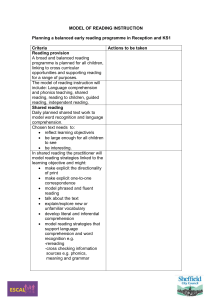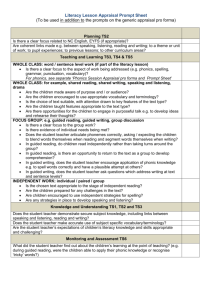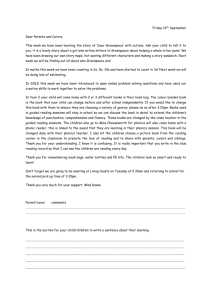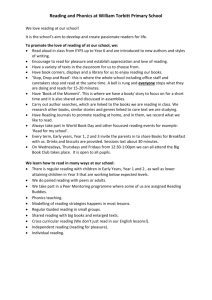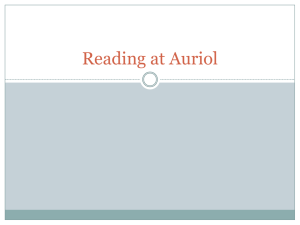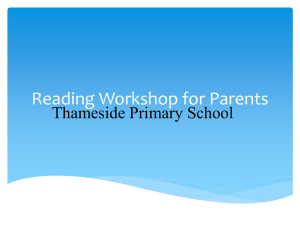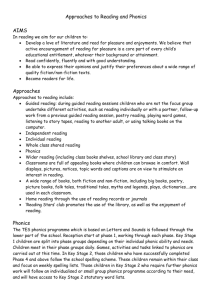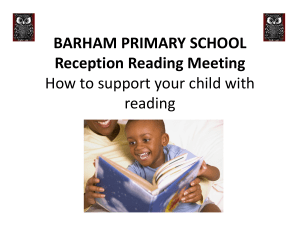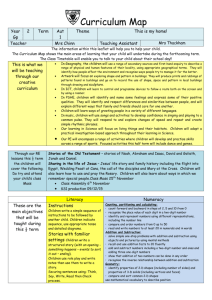Reading Policy Feb 2014 - St Winifred`s RC Primary School
advertisement
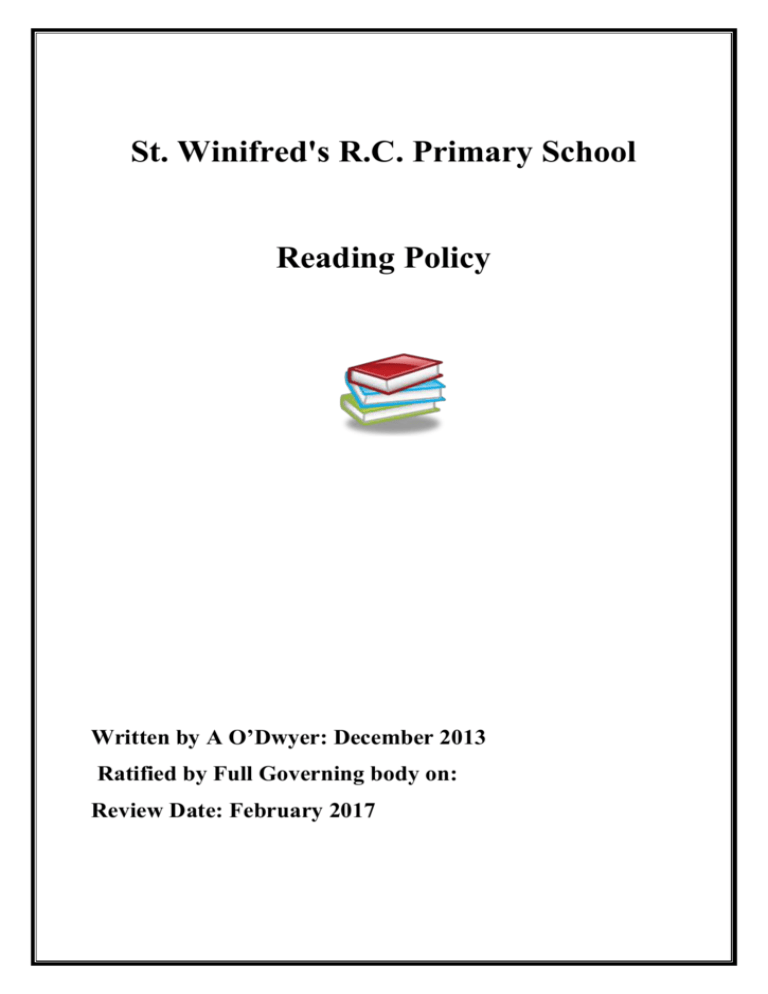
St. Winifred's R.C. Primary School Reading Policy Written by A O’Dwyer: December 2013 Ratified by Full Governing body on: Review Date: February 2017 Mission Statement “St. Winifred’s is a Catholic School which, through a balanced curriculum, endeavours to nurture and teach the Roman Catholic Faith by creating an environment where the Gospel values of love, peace, truth and justice are demonstrated. The school is concerned with the whole person, with living as well as learning, valuing all members of the school family as well as the diverse and changing world in which we live’’. Rationale St Winifred’s RC Primary School have a clear, consistent, whole school approach to reading. Competence in reading is key to independent learning and is given the highest priority at our school, enabling the children to become enthusiastic, independent and reflective readers. Success in reading has a direct effect upon progress in all other areas of the curriculum and is crucial to developing children’s self-confidence and motivation. Aims · To encourage the enjoyment of books and reading so that the children develop a life-long love of books. · To build on the child’s prior knowledge and early literacy experience. · To recognise and value the parents/carers role as prime educators in the pre-school years and work together to develop the child’s reading skills. · To provide the children with the skills and strategies necessary to develop into competent and fluent readers. · To teach our pupils to become confident, independent reflective readers who read from a range of texts for a variety of purposes. · To deliver a structured and progressive whole school approach to the teaching of reading . · To create a reading culture by providing a rich language environment within the classroom and throughout the school. · To select appropriate resources to motivate, challenge and extend pupils effectively. · To identify pupils who require additional support and intervene at an early stage. · To monitor reading progress and levels of attainment closely. · To promote an ethos of achievement by setting high expectations and challenging targets. · To develop in the children a critical appreciation of the work of authors, poets and illustrators in order to emulate these skills in their own writing. Objectives Reading is closely linked with writing- the two activities reinforce each other. Children become successful readers by using a range of strategies to get to the meaning of the text. At St Winifred’s RC Primary School we believe that literate children should: · · · · · · · · · · Read with confidence, fluency and understanding Read with enjoyment, evaluating and justifying their preferences Be taught the full range of reading strategies including: phonic knowledge (visual information) grammatical knowledge (structural information) word recognition and graphical knowledge (visual information) contextual knowledge (meaning) Understand the sound and spelling system and use this to read and spell accurately Be able to monitor their own reading and correct their own mistakes Develop a varied and rich vocabulary through the exploration of words and their meaning Read a range of genres in fiction and poetry Be able to use a range of non-fiction texts appropriately, including the Internet Discuss books with reference to author, illustrator, genre, theme and characters; expressing personal responses See the reading process modelled by adults and regularly take part in whole class, small group and individual reading activities Teaching and Learning In line with our Teaching and Learning policy, we aim to provide high levels of motivation and active participation for all our children. The N.C. provides a framework for a broad and balanced curriculum. It is important to follow a reading scheme, which can support the children in their efforts to read. At St. Winifred's we use a range of published materials for individual reading books including: Oxford Reading tree (ORT) and Pearson Phonic Bugs. Children take home their individual reading books and are expected to read these daily. Parents are encouraged to sign and comment in their child's reading diary. Additional support is given when and where appropriate. (See Appendix I for each Year Group’s approach) Children have the opportunity to take part in one to one, guided and shared reading sessions. We also acknowledge the need for a wide range of books and so provide a variety of fiction, play scripts, poetry and non-fiction. Guided reading books are taken from a wider range of commercially produced books (e.g. Usborne, Scholastic, Rigby), and include cross-curricular texts in a range of genre. Progression The teaching of reading and the strategies used by the teachers in each year group is tailored to ensure maximum progression for all children. Foundation Stage Within the first term in Reception, each of the children is assessed on the following: recognition of ‘pure sounds’ from Phase 2 of Letters and sounds recognition of letter names (as and when each child is ready) recognition of the first 100 high frequency words their general interest in books, how they hold books, turn pages etc. their individual response to the daily phase 2 phonics session Following these assessments, children are either given flash cards to take home, or a reading book. Once a child is ready for reading books, they are placed on our reading scheme, and a record of the books they have read is kept for each child in the class reading file. The reading scheme is organised into Letters and Sounds phases, from Phase 2 – 5. There are a selection of decodable books and other texts within each phase. Children are given two reading books at a time: one decodable, one non-decodable. The reading books that a child is on will reflect their phonics phase as closely as possible. There is a twenty minute phonic lesson within both classes. Each child is heard read at least once a week by their class teacher (either individually or through guided reading).They may also be heard by other adults throughout the week. A record of individual reading is made in their home-school reading record book, and a record of guided reading in the class teacher’s guided reading file. Individual reading books are changed twice a week. Parents are asked to read daily with their child and to record this in the home-school reading record book. Each child’s security within a particular phonic phase is assessed half termly, and tracked throughout the year, as is the correlation between their reading book and phonic phase. Children are also put into guided reading groups within the class. The children will participate in guided reading weekly. Guided reading books are also grouped into phonic phases, and a record is kept of the guided reading books read. Each child is also assessed regularly on their recognition of the 100 High Frequency reception words, and the record of these assessments is passed to the Year 1 teacher at the end of the year, as are the reading tracking and phonics tracking. There will also be a list of focus children (those children who are assessed as ‘emerging’ within their reading) given to the Year 1 class teacher. High frequency word lists are sent home to enable parents to support the child in their reading and spelling of them. Key Stage 1 End of year assessments of phonics phase security, high frequency word acquisition and Early Learning outcomes in reading are passed onto Year 1 teachers, who continue this assessment process. Children are also assessed using the seven assessment focuses for reading. This includes the use of some written reading assessments which are administered at the teacher’s discretion to monitor whether a child is secure within a book band or whether he or she should be fast tracked to a subsequent book band. Each child has an individual assertive mentoring file, which contains a section on their reading attainment and achievement. Progress in reading is a focus for each child’s individual mentoring sessions and targets are set and reviewed at least termly. In Years 1 & 2 the children continue with two individual reading books (one decodable, one non-decodable) until they are secure at the Letters and Sounds phonics Phase 5. Once Phase 5 is completed the children move onto the book band system, from Turquoise to St Winifred’s Band. These book bands consist of a range of ORT books and other published materials. As in Reception, each child is heard read once a week by their class teacher (either individually or within a guided reading session). They may also be heard by other adults throughout the week, and certain children are heard daily. A record of individual reading is made in their home-school reading record book and a record of guided reading is made in the class teacher’s guided reading file. Individual reading books are changed twice a week in Year 1 and up to three times a week in Year 2. Parents are asked to read daily with their child and to record this in the home-school reading record book. Guided reading sessions take place weekly and outcomes of any assessments are recorded in the class teacher’s guided reading file. Each child’s security within a particular phonic phase is assessed half termly, and tracked throughout the year, as is the correlation between their reading book and phonic phase. From Year 1 to Year 3, the children are streamed for the daily 25 minute phonics lesson and there are usually eight ability groups across the three year groups. Key Stage 2 End of year assessments of phonics phase security, high frequency word acquisition, reading tracking and a list of focus children (those underattaining or underachieving) in reading are passed onto all teachers, who continue this assessment process. Children are also assessed using the seven assessment focuses for reading. This includes the use of some written reading assessments which are administered at the teacher’s discretion to monitor whether a child is secure within a book band or whether he or she should be fast tracked to a subsequent book band. Each child has an individual assertive mentoring file, which contains a section on their reading attainment and achievement. Progress in reading is a focus for each child’s individual mentoring sessions and targets are set and reviewed at least termly. The children continue with two individual reading books (one decodable, one nondecodable) until they are secure at the Letters and Sounds phonics Phase 5. Once Phase 5 is completed the children move onto the book band system, from Turquoise to St Winifred’s Band. These book bands consist of a range of ORT books and other published materials. Each child is heard read once a week by their class teacher (either individually or within a guided reading session). They may also be heard by other adults throughout the week, and certain children are heard daily. A record of individual reading is made in their home-school reading record book and a record of guided reading is made in the class teacher’s guided reading file. Individual reading books are changed as and when necessary throughout Key Stage 2. Parents are asked to read daily with their child and to record this in the home-school reading record book. In Year 3, each child’s security within a particular phonic phase is assessed half termly, and tracked throughout the year, as is the correlation between their reading book and phonic phase. The Year 3 children are streamed for the daily 25 minute phonics lesson with Years 1 and 2. Guided Reading throughout School For guided reading the class is divided into groups of no more than 8 children of similar reading ability. Each group has one guided reading session each week which is explicit on the weekly timetable. The text is carefully selected at instructional level for the group and plans for each session reflect a specific teaching focus appropriate to the group. At St Winifred’s we aim to contextualise the guided reading as much as possible through the use of a range of crosscurricular texts. Structure of a Guided Reading Session Book Introduction This provides the context for the reading. The teacher will activate children’s prior knowledge and/or discuss the main themes of the text, including some prediction of the contents. Strategy Check Just prior to independent reading the teacher guides the children to focus on and apply key strategies while reading independently. Independent Reading Children will read independently while the teacher gives focused attention to support, monitor and assess individuals as they read. This will inform Assessment focus 1. Returning to the Text The teacher asks questions, promotes discussion and interacts with the children to extend their thinking and develop their responses to the text. This will inform assessment focuses 2-7, depending on the focus of each particular session. Equal Opportunities Each child regardless of gender, ethnicity, cultural background or ability will receive equal access and status to the reading curriculum. Pupil Premium funding has been used to purchase resources to support our most vulnerable children, including: Playclub Playbags and Better Reading partnership (BRP) materials. We aim to stimulate children's imagination and enthusiasm and develop their knowledge of the world by introducing a wide range of literature from diverse cultures. Differentiation Reading books are differentiated on an individual basis. Children are put into guided reading groups based on their reading ability. Their names are plotted on a reading quadrant grid from Year 1 onwards, to inform this grouping. These groups are reviewed regularly. Each group is then taught according to their ability and reading targets. Reading materials are differentiated accordingly. Differentiated group reading targets are also set and reviewed at least termly through the assertive mentoring process. Assessment, Recording and Reporting The following seven assessment focuses are used to assess throughout Y1-6: Assessment Focus 1 (AF1): Use a range of strategies, including decoding of text, to read for meaning Assessment Focus 2 (AF2: Understand, describe, select or retrieve information, events or ideas from texts and use quotation and reference to text Assessment Focus 3 (AF3): Deduce, infer or interpret information, events or ideas from texts Assessment Focus 4 (AF4): Identify and comment on the structure and organisation of texts, including grammatical and presentational features at text level. Assessment Focus 5 (AF5): Explain and comment on writer’s use of language, including grammatical and literary features at word and sentence level. Assessment Focus 6 (AF6): Identify and comment on writer’s purposes and viewpoints, and the overall effect on the reader. Assessment Focus 7 (AF7): Relate texts to their social, cultural and historical traditions. Each term NC levels of attainment are given to each pupil (Y1-6) and group targets are set. The progress and attainment of all children is then analysed by the English subject leader, who meets with staff in pupil progress meetings to discuss outcomes and agree intervention. End of year levels of attainment are shared with parents in the school report. The NC levels will be used until the Government’s new assessment arrangements are in place (2014-2015). The ORT assertive mentoring assessment materials are used diagnostically to ensure that individual reading books are suitably matched, and to aid the setting of more individualised reading targets. These materials are also linked to the seven assessment focuses. The reading diary provides a good opportunity for informal contact between school and parents. In addition, each teacher records individual books read by a child, together with the date. Outcomes of guided reading sessions are also recorded, and evidence used to inform teacher assessment is kept, if appropriate. These records are then passed on to the next teacher. Inclusion We support all children in their reading through differentiation and intervention if necessary. Outcomes of the termly analysis will inform future provision mapping and intervention. A variety of approaches will be used to support progress, including daily one to one reading; the implementation of the BRP programme and the Teaching Early Language and Literacy (TELL) programme. Special Educational Needs Some children may require additional support in reading. If necessary, a pupil profile will be set up (‘ School Action’ children) and an Individual Education Plan will be drawn up, in consultation with parents and the SENco (‘School Action +’ children). The Reading Environment All classrooms throughout the school have designated reading areas. Class libraries are well organised, topic related and supported by attractive displays. Pupils are exposed to a range of genres (both handwritten and word processed) throughout the school. The library contains a good selection of fiction and non-fiction books. The children are encouraged to take books out on a weekly basis. Each class is timetabled for one library session per week. Fiction books are shelved in alphabetical order by the author’s name. There are a large selection of picture books and some dual language books. Non-fiction books are catalogued using the Dewy System. Each class teacher has the opportunity to take out a large amount of books related to the topic they are teaching. Opportunities For ICT In English lessons the Interactive Whiteboard is used to support the teaching and learning of all children. The reading curriculum is also supported by visual and audio resources from Scholastic. Many programmes can be found on the network including Clicker 4, Literacy Bank, Star Spell, Read Write Inc, ORT Talking Stories, Elf Tales, Rhyme & Analogy, Word Shark, Naughty Stories. BBC Bitesize websites are also used throughout school alongside many other appropriate websites for research purposes. Home/School Links We recognise that parents play an active part in all aspects of their children’s learning and particularly in helping them to read successfully. We feel that a child should be read to regularly and be given the opportunity to read a range of genres daily. This daily practice is vital to maximise progress. The reading diary is a channel for daily communication regarding a child’s individual reading. Reading workshops, questionnaires and meetings are used to enhance this communication further. Links to seful reading and phonics based websites are placed in the ‘Parents’ section of the VLE. We have at least 12 parents who regularly come into school to hear children read individually and support reading within school. A child’s progress in reading, and their future targets are communicated to parents termly through Parents’ Meetings and End of Year reports. The Role of the Class Teacher · All teaching staff are responsible for developing our whole school approach to reading All teaching staff will model good reading behaviour and encourage the children to care for the reading matter in our school All teaching staff will encourage all children to learn the value of a life-long love of reading · All teaching staff will ensure that their classrooms are well stocked with attractive and appropriate books that reflect the topics being taught · All teaching staff will ensure that their classrooms are print rich and that the books available reflect different cultures, genders and languages both in fiction and nonfiction, ensuring provision is made for those with English as an additional language · All teaching staff will ensure provision of appropriate literature is made for any child with Special Educational Needs · All teaching staff will ensure the children have weekly access to the school library and model how to use it appropriately · All teaching staff will set reading targets for each child, keep up to date with record keeping and assessment, and ensure all reading information in kept in their reading folders Monitoring and Evaluation The standards and quality of the teaching and learning of reading is monitored in the following ways; · Termly analysis of pupil attainment and progress in reading and phonics - English Subject Leader. · Termly analysis of intervention strategies used – Teaching assistant, Class teacher, English Subject Leader · Lesson observations and observations of assertive mentoring sessions · Regular work scrutiny, pupil interviews · Feedback from parents
